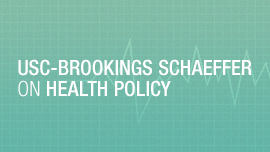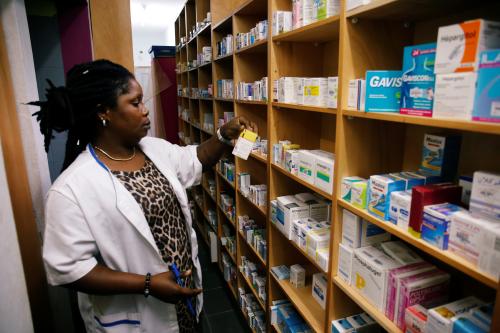This analysis is part of the USC-Brookings Schaeffer Initiative for Health Policy, which is a partnership between Economic Studies at Brookings and the University of Southern California Schaeffer Center for Health Policy & Economics. The Initiative aims to inform the national health care debate with rigorous, evidence-based analysis leading to practical recommendations using the collaborative strengths of USC and Brookings. This post originally appeared in Health Affairs on May 15, 2020.
The Covid-19 pandemic is fundamentally disrupting the health care system and injecting significant uncertainty about current and future utilization and costs. Medicare Advantage (MA) plans serve over 35 percent of Medicare beneficiaries, and elderly individuals appear particularly susceptible to the contagion. Despite being in the early stages of the pandemic, MA plans are currently making financial decisions about costs, premiums, and benefits for 2021. MA plans and standalone prescription drug plans (PDPs) must submit their bids for the benefit year starting on January 1, 2021 on June 1, 2020. Submitting bids in June provides the lead time needed for the annual October 15, 2020 to December 7, 2020 “open enrollment” period when Medicare beneficiaries choose their preferred coverage option.
Facing real uncertainty, health plan actuaries are likely to raise plan bids, meaning higher costs for enrollees and the federal government and fewer benefits for enrollees. Establishing temporary high cost reinsurance and risk corridors—now available to PDPs but not MA plans—would significantly mitigate risk and limit disruption in the MA market until the impacts of Covid-19 become better understood. A mandatory demonstration lasting a year or two, under the auspices of the Center for Medicare and Medicaid Innovation, would permit gathering experience and data, after which intervention in the MA market would no longer be needed.
Background
The Covid-19 pandemic is raging through the United States, upending lives, society, the economy, and health care. Neither the initial nor future effects of the contagion are currently known or reliably estimable, although early experience indicates Medicare beneficiaries—seniors and the disabled—are particularly susceptible to serious illness and death from this virus. Projecting 2021 costs depends not only on estimating current cost but also projecting the duration and effectiveness of social distancing, possible seasonality of the virus, the development, timing, and prices of treatments and vaccines, and the progression (including potential recurrences) of the contagion.
Initial experience suggests the pandemic has led non-Covid-19 utilization and claims to plummet due to social distancing, patient and clinician fear of becoming infected and hospitals limiting elective procedures to free up staff and materials for COVID-19 treatment. Not only is it unclear whether these patterns will persist for the third and fourth quarters of 2020, but it is unclear whether claims and utilization in 2021 will revert to prior patterns, remain markedly lower, or experience a “catch-up” surge.
When the Medicare Modernization Act of 2003 (MMA) created an outpatient prescription drug benefit, there was doubt about whether a viable insurance market would form because drug-only insurance was not offered commercially; uncertainty arising from the lack of credible data on Medicare beneficiary drug utilization and spending put insurers at high risk—in contrast to MA, where plans had decades of experience and access to extensive FFS data. The MMA included three mechanisms to encourage bidding by reducing risk for insurers: linking payment to a beneficiary’s expected cost through risk adjustment; high-cost reinsurance that greatly limited plan liabilities for individuals incurring catastrophic drug expenses; and, through risk corridors, limiting aggregate plan losses or clawing back excess profits if costs exceeded or undershot a bid by more than a specified percentage.
Although designed to help create and insurance market, the three mechanisms remain in effect for PDPs today. Of the three, only risk adjustment exists in the MA market. Risk adjustment in 2021 for both MA plans and PDPs reflects spending and health conditions in prior periods and would not incorporate Covid-19 costs incurred 2020.
Proposal
Use the existing demonstration authority of CMMI (within the Centers for Medicare and Medicaid Services) to create a mandatory program for 2021 MA bids with two elements: limit a plan’s losses if it has an actuarially unexpected number of patients with costs above a pre-set catastrophic threshold (reinsurance); and limit plan losses or claw back excess profit if actual costs deviate significantly from bids (risk corridors).
Limiting Risk
Because they mitigate different types of risk, the combined effect of the programs more thoroughly limits uncertainty than either would individually. Uncertainty associated with the pandemic could markedly increase the number of MA beneficiaries incurring catastrophic expenses if, for example, many elderly beneficiaries become infected in 2021 and require expensive intensive care hospitalizations. Alternatively, successfully controlling the pandemic by the end of 2020 might cause a surge in average costs (without spurring an increase in catastrophic cases) as beneficiaries utilize services in 2021 that they deferred in 2020. On the other hand, MA plans might incur significantly lower than expected costs in 2021 if, for example, Covid-19 puts elderly beneficiaries at high risk and they continue to practice aggressive social distancing and utilize many fewer health care services than projected.
Timing
To avoid delaying open enrollment, CMS would have to rapidly implement the proposed high cost reinsurance and aggregate loss/claw-back programs. Plans would need to have the program details in time to permit incorporating the programs into their bids. CMS could modestly modify the current deadline by continuing to require submission of full bids on June 1 but setting a subsequent date (e.g., July 1) for a revised submission of bid costs. The revised bid cost submission would incorporate the risk sharing programs; no other aspects of a plan’s submission, such as benefits, cost sharing, or provider networks, could be updated.
Parameters For High-Cost Reinsurance
The parameters for Medicare high cost reinsurance would reflect actual experience in prior years. The Medicare Actuary would rely heavily on past spending data to compute (i) the expected cost of the reinsured portion of spending and (ii) the percentage reduction in monthly plan premiums needed to offset the expected cost. Catastrophic thresholds (“attachment points”) and the reinsured percentage of losses (above the thresholds) might be set to equal 1 percent of expected spending. Medicare reinsurance costs for 2021 would exceed dedicated financing—the amount of plan premium withholding—if 2021 catastrophic spending exceeded projections; conversely, Medicare would save money if catastrophic costs were less than projected.
Reinsurance provided by Medicare would be more efficient and cost less than comparable commercial reinsurance for three reasons. First, the government, unlike private insurance, does not increase costs to cover volatility (i.e., charge a “risk premium”), sales expenses, and profit. Second, requiring all MA plans to participate in the government program would limit selection bias, such as would happen if plans expecting better than average experience opted out of reinsurance, which would increase the average cost of plans electing reinsurance. Third, Medicare would have an enormous risk pool, which confers a pricing advantage relative to the smaller risk pools available to commercial reinsurers.
Base High-Cost Reinsurance Thresholds on County-Level Spending
The geographic variation in per capita spending and MA benchmark rates effectively precludes establishing a nationally uniform reinsurance program, even after standardizing beneficiary characteristics and controlling for health status. Because Medicare fee-for-service (FFS) spending and MA payment rates vary markedly at the county level, the same dollar threshold would result in starkly different levels of risk sharing and financial protection. Standardized, risk-adjusted FFS spending per beneficiary in the least expensive county in the country averages only 26 percent of spending in the most expensive county. MA rates in the least expensive county are 43 percent of those in the most expensive county. Just within Texas, MA rates in the most expensive county (Collingsworth) are double those in the least expensive county (Presidio).
The importance of acting expeditiously argues for basing program parameters on readily available, reliable data. Medicare FFS data provide a solid basis for the Medicare Actuary to compute the dollar-level thresholds such that catastrophic reinsurance would capture a consistent share of spending in each county (e.g., the top 1 percent), potentially classifying counties into categories such as very low, low, medium, high, and very high cost.
Financial Considerations For Aggregate Loss/Claw-Back Protection Through Risk Corridors
A two-sided aggregate loss protection/claw-back program would have the same threshold (e.g., +/-5 percent) for triggering extra payments to, or clawing-back funds from, plans. Assuming actual financial results for plans were randomly distributed with respect to bids, clawed-back amounts should offset payments for aggregate losses. (A provision requiring MA plans to spend at least 85 percent of their premiums on medical costs can interact with the claw-back, but the claw-back would more directly recapture funds from plans and benefit the government.)
In normal times and with adequate information, relatively few MA plans would have losses or profits that exceeded the permissible threshold percentage. In periods of substantial uncertainty—when plans are, in essence, placing bets—bids might be equally likely to be overstated or understated. However, if most plans made similar assumptions about the effects of Covid-19 that turned out to be incorrect, bids might be systematically overstated (if costs were less than projected) or understated (if costs were greater than projected).
For the first year of the new drug benefit (2006), PDP bids almost uniformly guessed too high and overstated their costs, which triggered large claw-backs. If uncertainty about 2021 MA costs were to cause plans to overstate the actual costs they incurred in 2021, the claw-back could produce significant savings for Medicare; conversely, having bids systematically understate actual costs would generate additional payments from Medicare.
Federal Savings
Recognizing that estimating the savings or cost of the proposed demonstration is complicated and uncertain, the two mandatory components of my proposal are likely to lower plan bids relative to what they would have been under current rules. The combination of reinsurance and aggregate loss/claw-back risk corridors lowers plan costs by reducing overall risk, which should lower plan bids (because the risk premium associated with their bids is reduced). As previously discussed, the superior efficiency of mandatory federal risk mitigation programs lowers costs relative to what plans would pay for comparable levels of commercial reinsurance and aggregate stop-loss protection. Lessening risk and lowering risk premia reduces federal costs by lowering bids.
Determining MA Plan Spending For Risk Corridors
Claims or encounter data would constitute the basis for calculating plan spending relative to risk corridor thresholds, which would be based on the plan’s bid. Unlike PDPs, questions remain about the accuracy and completeness of MA encounter data reporting, notwithstanding the increasing reliance of MA risk adjustment on—and the requirement that MA plans report—encounter data. (Because outpatient drug claims are processed at the point of sale employing standardized data and reporting protocols, information derived from drug claims is generally regarded as reliable.)
If the accuracy of MA plan spending remains a concern for determining whether and how much a plan qualifies for risk corridor payments (or owes Medicare money from underspending), plans could have their encounter reporting audited, with financial penalties for incomplete or inaccurate reporting. Such a requirement would have the additional benefit of making encounter data reporting more complete, which would be useful for many other policy purposes.
CMMI Authority And Need For Mandatory Demonstration
CMMI has broad authority to implement demonstrations and alter statutory provisions if the demonstration is assessed as meeting certain requirements, such as saving money. Evaluating whether the demonstration saved Medicare money would depend on two components: plan bids and actual spending. The financial effect on plan bids of reinsurance and risk corridors would reflect the difference between bids submitted on June 1 under current rules compared to bids resubmitted under the demonstration, plus the reinsurance premium retained by Medicare (which reduces monthly capitation paid to plans). Actual Medicare spending on MA would be determined after 2021 ends and would reflect payments for reinsurance and the net amount of risk corridor payments. (Under the symmetric risk corridor program, a plan would pay Medicare money if its bid significantly exceeded its actual cost; conversely, Medicare would pay a plan money if its costs significantly exceeded its bid.)
CMS has previously indicated it has the ability to mandate participation in a CMMI initiative. Importantly, mandatory participation would limit risk selection (e.g., having plans opt out because they think they would be financially better off, while only plans that think they would benefit financially participate). Mandatory participation also would simplify setting reinsurance thresholds and facilitate more stability in MA bidding. A mandatory program would simplify program design and speed implementation.
Permitting MA plan participation to be voluntary would likely cause adverse selection, as well as significantly complicating both setting reinsurance parameters and estimating savings. While this policy could also be pursued through legislation rather than a mandatory CMMI demonstration, it is very unlikely that the Congress could act in a timely enough way for this approach to be practical for 2021 bids.
The Brookings Institution is committed to quality, independence, and impact.
We are supported by a diverse array of funders. In line with our values and policies, each Brookings publication represents the sole views of its author(s).










Commentary
Adapting Medicare Advantage bidding for COVID-19 related uncertainty on claims: A proposal
May 18, 2020